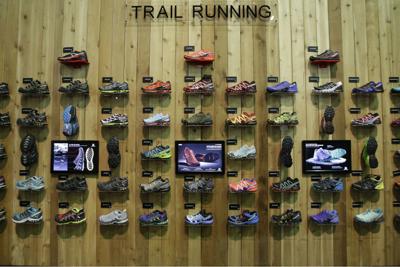Most running shoes feel comfortable when you’re standing in a shoe store, but the true test comes several miles into your run.
Your ideal shoe corresponds with your running style and the shape of your foot.
In general, a pair of running shoes should last 400 to 500 miles. If your midsoles and outsoles are compressed or worn, it’s probably time for new shoes.
SHOE TYPES
Road-running shoes are designed for pavement and occasional forays onto packed surfaces with slight irregularities. Light and flexible, they’re made to cushion or stabilize feet during repetitive strides on hard, even surfaces.
Trail-running shoes are designed for off-road routes with rocks, mud, roots or other obstacles. They are enhanced with aggressive tread for solid traction and fortified to offer stability, support and underfoot protection.
Cross-training shoes are designed for gym or Crossfit workouts or any balance activity where having more contact with the ground is preferred over a thick platform sole.
Barefoot/minimalist running In traditional running shoes, feet tend to hit the ground heel first. This is because a shoe heel has an elevated cushion. With barefoot runners, it is the mid-foot or forefoot that strikes the ground first.

Professional long-distance and mountain runner Joseph Gray hits the Manitou Incline (best time 17:45).
HOW DO YOU RUN?
If you own a well-used pair of running shoes, check the wear pattern on the soles to help determine your running mechanics.
Pronation shows a wear pattern centralized to the ball of the foot and a small portion of the heel. It is the foot’s natural inward roll following the heel striking the ground.
Basic (neutral) pronation helps absorb impact, relieving pressure on knees and joints. It is a normal trait of neutral, biomechanically efficient runners.
Overpronation is identified by wear patterns along the inside edge of your shoe, and is an exaggerated form of the foot’s natural inward roll. Overpronation is a common trait that leaves runners at risk of knee pain and injury. Overpronators need stability or motion control shoes.
Supination (also called under-pronation) is marked by wear along the outer edge of your shoe. It is an outward rolling of the foot resulting in insufficient impact reduction at landing. Runners who supinate need shoes with cushioning and flexibility.
SHOE DETAILS
Cushioning shoes: Best for mild pronators, supinators or neutral runners for off-pavement runs. Provide increased shock absorption and some medial (arch-side) support. Some super-cushioned shoes provide as much as 50% more cushioning than traditional shoes for even greater shock absorption and stability.
Stability shoes: Good for neutral runners or those who exhibit mild to moderate overpronation. They often include a firm “post” to reinforce the arch side of each midsole, an area highly impacted by overpronation.
Motion control shoes: Best for runners who exhibit moderate to severe overpronation. Offer features such as stiffer heels or a design built on straighter lasts to counter overpronation.
Barefoot shoes: Soles provide the bare minimum in protection from potential hazards on the ground. Many have no cushion in the heel pad and a thin layer of shoe between your skin and the ground. Barefoot shoes feature a “zero drop” from heel to toe. (“Drop” is the difference between the height of the heel and the height of the toe.) This encourages a mid-foot or forefoot strike.
Minimalist shoes: These feature extremely lightweight construction, little to no arch support and a heel drop of about 4–8mm to encourage a natural running motion and a midfoot strike, yet still offer cushioning and flex. Some minimalist styles may offer stability posting to help the overpronating runner transition to a barefoot running motion.
UPPERS
MIDSOLES
The midsole is the cushioning and stability layer between the upper and the outsole.
OUTSOLES
Most road shoes are made with rugged carbon rubber in the heel. Blown rubber—which provides more cushioning—is often used in the forefoot. Trail runners tend to have all carbon rubber outsoles to better withstand trail wear, while road-racing shoes are frequently all blown rubber to reduce weight.
Heel-to-Toe Drop The drop of a shoe represents the difference between the height of the heel and the height of the toe. This primarily affects how your foot strikes the ground when you land. A low or medium heel-to-toe drop (zero to 8mm) promotes a forefoot or mid-foot strike, while a high-drop shoe (10–12mm) promotes heel striking. Note: Heel drop and cushioning are independent of each other. It is possible to find ultra-cushioned shoes that still have a zero or low heel-to-toe drop, for example.
Heel Counter This refers to the rigid structure around the heel. It provides motion control and is sometimes supplemented with a heel wedge, which adds support and cushioning to the heel. It can help those runners who are bothered by Achilles tendonitis.
Medial Post or Torsion Bar These are located on the sides of shoes to help control excessive inward or outward motion. They are designed for the over-pronator or supinator.









(0) comments
Welcome to the discussion.
Log In
Keep it Clean. Please avoid obscene, vulgar, lewd, racist or sexually-oriented language.
PLEASE TURN OFF YOUR CAPS LOCK.
Don't Threaten. Threats of harming another person will not be tolerated.
Be Truthful. Don't knowingly lie about anyone or anything.
Be Nice. No racism, sexism or any sort of -ism that is degrading to another person.
Be Proactive. Use the 'Report' link on each comment to let us know of abusive posts.
Share with Us. We'd love to hear eyewitness accounts, the history behind an article.